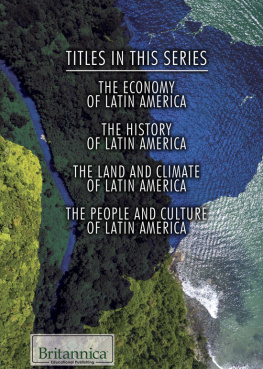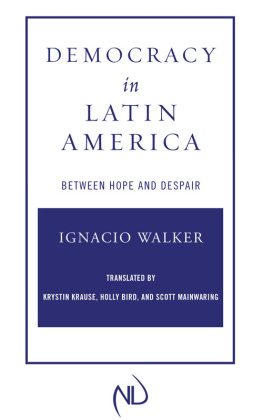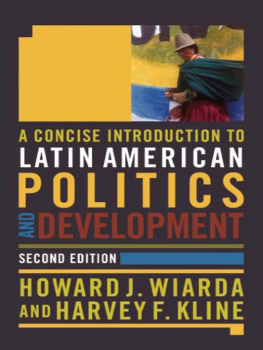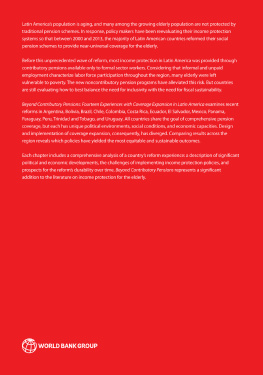ARAB AND JEWISH IMMIGRANTS IN LATIN AMERICA
Images and Realities
OF RELATED INTEREST
RUSSIAN JEWS ON THREE CONTINENTS
Emigration and Resettlement
edited by Noah Lewin-Epstein, Yaacov Roi and Paul Ritterband
JEWS, CHRISTIANS AND MUSLIMS IN THE MEDITERRANEAN WORLD AFTER 1492
edited by Alisa Meyuhas Ginio
THE SHAPING OF ISRAELI IDENTITY
Myth, Memory and Trauma
edited by Robert Wistrich and David Ohana
THE JEWISH EXODUS FROM IRAQ 1948-51
by Moshe Gat
JEWS AND JEWISH LIFE IN RUSSIA AND THE SOVIET UNION
edited by Yaacov Ro i
THE JEWISH HERITAGE IN BRITISH HISTORY
Englishness and Jewishness
edited by Tony Kushner
ARAB AND JEWISH IMMIGRANTS IN LATIN AMERICA
Images and Realities
Edited by
IGNACIO KLICH and JEFFREY LESSER
First published in 1998 in Great Britain by
Routledge
2 Park Square, Milton Park, Abingdon, Oxon, OX14 4RN
270 Madison Ave, New York NY 10016
Transferred to Digital Printing 2007
Website http://www.routledge.com
Copyright 1998 Routledge
British Library Cataloguing in Publication Data
Arab and Jewish immigrants in Latin American : images and realities
1. Arabs - Latin America 2. Jews - Latin America 3. Latin Americans - Foreign countries 4. Latin America - Emigration and immigration 5. Latin America - Emigration and immigration - Religious aspects
I. Klich, Ignacio II. Lesser, Jeffrey
304.88056
ISBN 0 7146 4873 6 (cloth)
0 7146 4450 1 (paperback)
Library of Congress Cataloging-in-Publication Data
Arab and Jewish immigrants in Latin America : images and realities / edited by Ignacio Klich and Jeffrey Lesser,
p. cm.
This group of studies first appeared in a special issue ... of Immigrants and minorities, vol. 16, nos. 1 & 2, March/July 1997 --T.p. verso.
Includes bibliographical references and index.
ISBN 0-7146-4873-6. ISBN 0 7146 4450 1 (pbk.)
1. Jews--Latin America--History. 2. Arabs--Latin America--History. 3. Latin America--Ethnic relations. I. Klich, Ignacio, 1949 . II. Lesser, Jeff.
F1419.J4A73 1998 | 97-38796 |
980.004924-dc21 | CIP |
This group of studies first appeared in a Special Issue on Arab and Jewish Immigrants in Latin America: Images and Realities edited by Ignacio Klich and Jeffrey Lesser of Immigrants and Minorities, Vol.16, Nos.l&2, March/July 1997
All rights reserved. No part of this publication may be reproduced, stored in a retrieval system or transmitted in any form or by any means, electronic, mechanical, photocopying, recording or otherwise, without the prior permission of Routledge and Company Limited.
Publishers Note
The publisher has gone to great lengths to ensure the quality of this reprint but points out that some imperfections in the original may be apparent
Contents
Ignacio Klich and Jeffrey Lesser |
Ignacio Klich |
Jeffrey Lesser |
Louise Fawcett and Eduardo Posada-Carbo |
Brenda Gayle Plummer |
Daro A. Euraque |
Liz Hamui-Halabe |
Marc J. Osterweil |
Michael Humphrey |
Estela Valverde |
Fabiana Sabina Tolcachier |
TheresaAlfaro Velcamp |
Ignacio Klich and Jeffrey Lesser
In a 1996 lecture in South Africa, at the University of Capetown, the distinguished cultural and medical historian, Sander L. Gilman, challenged listeners to consider how scholars in ethnic studies generally, and Jewish studies specifically, might dismantle the paradigms that have so dominated these fields.1 Speaking on the new frontier of Jewish history, his major suggestion was that academics consider how Jews are just like everyone else, a possible English-language variant of another distinguished historians earlier efforts to alert a Francophone readership against Jewish exceptionalism2 Whatever their identity, many among Gilmans audience were, of course, incited to anger; naturally irritated by what were deemed to be provocative notions, they were infused in all likelihood by secular and religious versions of the chosenness of the Jewish people, insufficiently attuned to the earlier writings of the likes of Pierre Vidal-Naquet, the French Jewish intellectual of Greek antiquity (whose work is already available in languages other than French),3 or those of Anglo-Jewish academic, Bryan Cheyette. Against this background, the same reaction may have been witnessed had Gilmans audience been exposed to some of the thought-provoking ideas of Vidal Naquet,4 and Cheyette.5
To share the exceptionlist/essentialist sentiments that propelled a not insignificant number of Gilmans listeners to be irked by his boldness certainly would have made this collection of essays a virtual impossibility. Instead, this volume seeks to suggest how two groups for the most part with different places of origin, different religions and cultures, and even different dates of arrival may be like each other in more respects than one. And yet, such an ambitious editorial project could not have been undertaken satisfactorily without the utmost care, without sweeping under the carpet the differences between Arabs and Jews in Latin America, the Caribbean (hereafter Latin America) and elsewhere, and a concerted effort to avoid predicating the need to learn automatically from each others experience.
Plainly, if successful, this complex and hitherto unattempted task, an undoubted innovation in the historiography of both the region and these groups, has had to rely on the ability of all participating authors to stay clear of simplistic mathematical equations, an unforgivable sin when considering ethnic and other human groups. Clearly, it would have been idle to ignore that Arabs and Jews are far from identical units of analysis. At the same time, however, a comparative effort would have to de-emphasize or sideline notions of Jewish uniqueness. Far from being the only prerequiste, it would also have meant avoiding a significant Arab nationalist-inspired unwillingness (especially though not only among the most politically aware) of the descendants of yesteryears Syrian, Lebanese and Palestinian immigrants to Latin America to consider themselves on a par with Jews, of all peoples.
To be sure, a comprehensive comparative approach to Arabs and Jews required a radical rethink of at least some of the conventional wisdoms to which both groups have been exposed at least since the first of the Arab-Israeli wars, or to justify the most horrendous crimes that have been committed by all sides since the latter half of the 1940s or for other less terrible reasons.6 Indubitably, Arab-Israeli enmity has clearly impinged on the possibility of thinking along the lines of similarities between these two specific groups, or even of entertaining the crudest notion of equivalence of their respective experiences. And yet, as various authors show, such similarities clearly exist. More importantly, the Arab-Israeli conflict has made it all the more difficult though fortunately not impossible after the Egyptian-Israeli peace to solicit the corroboration of reliable ethnic sources on the elements of convergence suggested by a substantial corpus of pre-1948 literature.








